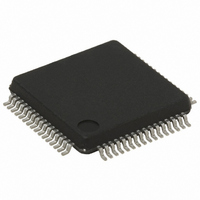ST7FMC2R7T6TR STMicroelectronics, ST7FMC2R7T6TR Datasheet - Page 128

ST7FMC2R7T6TR
Manufacturer Part Number
ST7FMC2R7T6TR
Description
IC MCU 8BIT 32K FLASH 64-LQFP
Manufacturer
STMicroelectronics
Series
ST7r
Datasheet
1.ST7FMC2S4T6.pdf
(309 pages)
Specifications of ST7FMC2R7T6TR
Core Processor
ST7
Core Size
8-Bit
Speed
8MHz
Connectivity
LINSCI, SPI
Peripherals
LVD, Motor Control PWM, POR, PWM, WDT
Number Of I /o
44
Program Memory Size
48KB (48K x 8)
Program Memory Type
FLASH
Ram Size
1.5K x 8
Voltage - Supply (vcc/vdd)
3.8 V ~ 5.5 V
Data Converters
A/D 16x10b
Oscillator Type
Internal
Operating Temperature
-40°C ~ 85°C
Package / Case
64-LQFP
For Use With
497-8402 - BOARD EVAL COMPLETE INVERTER497-8400 - KIT IGBT PWR MODULE CTRL ST7MC497-6408 - BOARD EVAL BLDC SENSORLESS MOTOR497-4734 - EVAL KIT 3KW POWER DRIVER BOARD497-4733 - EVAL KIT 1KW POWER DRIVER BOARD497-4732 - EVAL KIT 300W POWER DRIVER BOARD497-4731 - EVAL KIT PWR DRIVER CONTROL BRD
Lead Free Status / RoHS Status
Lead free / RoHS Compliant
Eeprom Size
-
Available stocks
Company
Part Number
Manufacturer
Quantity
Price
Company:
Part Number:
ST7FMC2R7T6TR
Manufacturer:
STMicroelectronics
Quantity:
10 000
- Current page: 128 of 309
- Download datasheet (6Mb)
ST7MC1xx/ST7MC2xx
LINSCI™ SERIAL COMMUNICATION INTERFACE (LIN Mode) (cont’d)
10.5.9.5 LIN Baud Rate
Baud rate programming is done by writing a value
in the LPR prescaler or performing an automatic
resynchronization as described below.
Automatic Resynchronization
To automatically adjust the baud rate based on
measurement of the LIN Synch Field:
– Write the nominal LIN Prescaler value (usually
– Set the LASE bit to enable the Auto Synchroni-
When Auto Synchronization is enabled, after each
LIN Synch Break, the time duration between five
falling edges on RDI is sampled on f
result of this measurement is stored in an internal
15-bit register called SM (not user accessible)
(See
sociated LPFR and LPR registers) are automati-
cally updated at the end of the fifth falling edge.
During LIN Synch field measurement, the SCI
state machine is stopped and no data is trans-
ferred to the data register.
10.5.9.6 LIN Slave Baud Rate Generation
In LIN mode, transmission and reception are driv-
en by the LIN baud rate generator
Note: LIN Master mode uses the Extended or
Conventional prescaler register to generate the
baud rate.
If LINE bit = 1 and LSLV bit = 1 then the Conven-
tional and Extended Baud Rate Generators are
disabled: the baud rate for the receiver and trans-
128/309
1
depending on the nominal baud rate) in the
LPFR / LPR registers.
zation Unit.
Figure
68). Then the LDIV value (and its as-
CPU
and the
mitter are both set to the same value, depending
on the LIN Slave baud rate generator:
with:
LDIV is an unsigned fixed point number. The man-
tissa is coded on 8 bits in the LPR register and the
fraction is coded on 4 bits in the LPFR register.
If LASE bit = 1 then LDIV is automatically updated
at the end of each LIN Synch Field.
Three registers are used internally to manage the
auto-update of the LIN divider (LDIV):
- LDIV_NOM (nominal value written by software at
LPR/LPFR addresses)
- LDIV_MEAS (results of the Field Synch meas-
urement)
- LDIV (used to generate the local baud rate)
The control and interactions of these registers is
explained in
on the LDUM bit setting (LIN Divider Update Meth-
od)
Note:
As explained in
can be updated by two concurrent actions: a
transfer from LDIV_MEAS at the end of the LIN
Sync Field and a transfer from LDIV_NOM due
to a software write of LPR. If both operations
occur at the same time, the transfer from
LDIV_NOM has priority.
Tx = Rx =
Figure 69
Figure 69
(16
and
f
CPU
*
LDIV)
Figure
and
Figure
70. It depends
70, LDIV
Related parts for ST7FMC2R7T6TR
Image
Part Number
Description
Manufacturer
Datasheet
Request
R

Part Number:
Description:
STMicroelectronics [RIPPLE-CARRY BINARY COUNTER/DIVIDERS]
Manufacturer:
STMicroelectronics
Datasheet:

Part Number:
Description:
STMicroelectronics [LIQUID-CRYSTAL DISPLAY DRIVERS]
Manufacturer:
STMicroelectronics
Datasheet:

Part Number:
Description:
BOARD EVAL FOR MEMS SENSORS
Manufacturer:
STMicroelectronics
Datasheet:

Part Number:
Description:
NPN TRANSISTOR POWER MODULE
Manufacturer:
STMicroelectronics
Datasheet:

Part Number:
Description:
TURBOSWITCH ULTRA-FAST HIGH VOLTAGE DIODE
Manufacturer:
STMicroelectronics
Datasheet:

Part Number:
Description:
Manufacturer:
STMicroelectronics
Datasheet:

Part Number:
Description:
DIODE / SCR MODULE
Manufacturer:
STMicroelectronics
Datasheet:

Part Number:
Description:
DIODE / SCR MODULE
Manufacturer:
STMicroelectronics
Datasheet:

Part Number:
Description:
Search -----> STE16N100
Manufacturer:
STMicroelectronics
Datasheet:

Part Number:
Description:
Search ---> STE53NA50
Manufacturer:
STMicroelectronics
Datasheet:

Part Number:
Description:
NPN Transistor Power Module
Manufacturer:
STMicroelectronics
Datasheet:

Part Number:
Description:
DIODE / SCR MODULE
Manufacturer:
STMicroelectronics
Datasheet:











